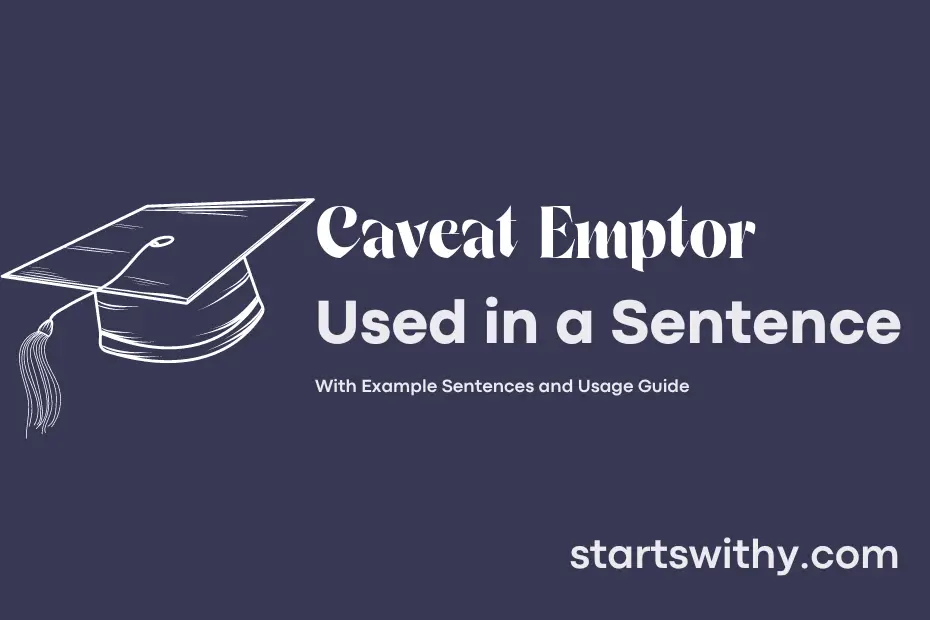Ever heard the phrase “caveat emptor”? This Latin term, translated to “let the buyer beware,” serves as a cautionary reminder for consumers to be vigilant and prudent when making purchases. In essence, it stresses the importance of conducting thorough research and being wary of potential risks or deceitful practices in the market.
Whether shopping for a new car or choosing an investment opportunity, the principle of caveat emptor highlights the responsibility of buyers to assess the quality and reliability of products or services before committing to a transaction. By staying informed and mindful of potential pitfalls, consumers can navigate the marketplace with greater confidence and avoid falling victim to deceptive schemes or subpar offerings.
7 Examples Of Caveat Emptor Used In a Sentence For Kids
- Always remember caveat emptor means “buyer beware”.
- Before buying anything, say caveat emptor to yourself.
- It’s important to understand what caveat emptor means.
- Use caveat emptor when making decisions about what to buy.
- Be careful and say caveat emptor before purchasing items.
- Remember the phrase caveat emptor when shopping.
- Make sure to think of caveat emptor before spending money.
14 Sentences with Caveat Emptor Examples
- When purchasing second-hand textbooks online, caveat emptor to ensure you’re getting the right edition.
- Before signing up for a student loan, remember to thoroughly read the terms and conditions – caveat emptor.
- Looking for a new laptop? Research the seller’s reputation and caveat emptor to avoid getting scammed.
- Thinking of buying a used bike for college commute? Don’t forget to inspect it closely – caveat emptor.
- Before enrolling in a coaching institute, make sure to double-check their success rates and reviews – caveat emptor.
- Joining a college club or society? Keep in mind to understand the membership fees and benefits beforehand – caveat emptor.
- Shopping for a new phone on a discount website? Exercise caution and caveat emptor to avoid counterfeit products.
- Renting a flat with friends for college? Make sure to carefully read the rental agreement – caveat emptor.
- Planning a group trip with classmates? Be wary of hidden costs and changes in the itinerary – caveat emptor.
- Considering taking up a part-time job for extra cash? Research the company’s reputation and caveat emptor.
- Interested in investing in the stock market? Remember to analyze market trends and caveat emptor before making decisions.
- Buying a used vehicle for college transportation? Have a mechanic inspect it and caveat emptor to avoid future repair costs.
- Subscribing to online study materials? Check for any hidden fees or recurring charges – caveat emptor.
- Attending a college festival with ticketed entry? Verify the event details and caveat emptor to prevent any last-minute inconveniences.
How To Use Caveat Emptor in Sentences?
Caveat Emptor is a Latin term that means “let the buyer beware.” It is commonly used in the context of purchasing goods and services to emphasize the buyer’s responsibility to ensure the quality and suitability of the product before making a purchase.
Here’s an example of how to use Caveat Emptor in a sentence: “Before buying a used car, always remember Caveat Emptor and thoroughly inspect the vehicle for any hidden issues.”
When using Caveat Emptor in a sentence, it is important to remember that it places the burden of due diligence on the buyer. This means that the buyer should be aware of potential risks and take the necessary precautions to protect themselves from fraud or deception.
Another example of using Caveat Emptor in a sentence: “When shopping online, it’s crucial to research the seller’s reputation and read product reviews to practice Caveat Emptor.”
In essence, incorporating Caveat Emptor into your vocabulary is a way to remind yourself and others to be cautious and informed when making purchasing decisions. By understanding and applying this principle, you can avoid falling victim to scams or buying products of inferior quality.
Conclusion
In summary, caveat emptor underscores the principle that buyers should beware and take responsibility for examining goods or services before making a purchase. When applied in transactions, this ancient legal maxim places the burden on the buyer to ensure they are getting a satisfactory deal without relying solely on the seller’s claims. For example, a signed contract may not protect a buyer if they fail to inspect a property thoroughly before buying it, as caveat emptor suggests that the buyer should have done their due diligence.
Ultimately, understanding and applying caveat emptor can empower consumers to make more informed decisions by encouraging them to thoroughly inspect products or services before buying. By being cautious and proactive in their purchases, individuals can better protect themselves from potential risks and ensure they are getting what they pay for.



